What made Steve Jobs unique?
- Published
Steve Jobs was a uniquely recognisable, charismatic and idiosyncratic leader. Here are some of the traits that made him the world's most talked about chief executive.
Knowing what you want before you want it
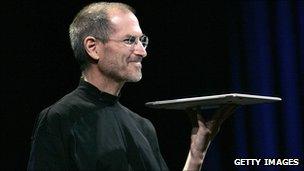
Steve Jobs was not a fan of market research. He famously said "You can't just ask customers what they want then try to give that to them. By the time you get it built, they'll want something new."
Instead, he relied on his own instinct for refining existing technologies, developing new products and packaging them in a way that people would want to use.
Before the iPod appeared in 2001, there was relatively little interest in MP3 music players. Those products that did exist were chunky, often fiddly to use, and were largely bought by early adopter tech enthusiasts.
So appealing were gadgets such as the iPod, iPhone and iPad that the public quickly engaged with them. That was due, in no small part, to Steve Jobs' ability as a salesman - explaining his products simply in a way that everyone could understand.
Reality distortion field
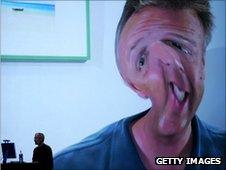
Steve Jobs knew how to work a crowd. He could build excitement around technologies which, sometimes, were neither new nor world changing.
When the iPad 2 launched, a large part of his presentation was dedicated to the device's "smart cover" - a square of vinyl with magnetic hinges. Yet it garnered significant media coverage.
Even seasoned journalists were not immune, with many finding that it took them several hours recovery time to fully make sense of the announcements.
The phenomenon was named the "reality distortion field". No other Apple executive has, as yet, demonstrated Steve Jobs' ability to generate it.
The uniform
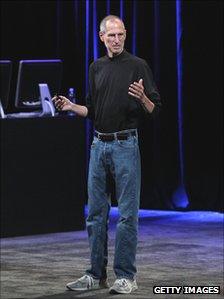
For the past decade, Steve Jobs almost always wore the same outfit.
From top to bottom, it was a black St. Croix mock turtleneck sweater, blue Levi 501 jeans, and New Balance 991 trainers.
The items may reflect his minimalist tastes, or perhaps his flair for personal as well as corporate branding.
Mr Jobs does not appear to have spoken publicly about his choice of clothing, although he is said to have told friends that he did not care about his appearance.
This was not always the case. During the 1980s he would regularly make public appearances in flashy Italian suits, and was even known to wear a colourful bow tie.
His distinctive appearance was often parodied by comedians.
Attention to detail
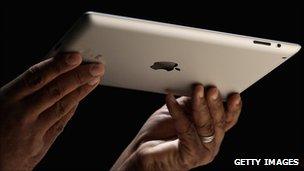
Apple is so secretive that little is known about its internal design processes, however stories do leak out, and most of those tell of Steve Jobs' fanatical attention to detail.
Google executive Vic Gundotra tells of the time that his company was partnering with Apple to put Google Maps on the iPhone.
Mr Gundotra received a personal call from Steve Jobs on a weekend, expressing displeasure that the second letter "o" was the wrong shade of yellow.
While British designer Jonathan Ive is responsible for the overall look and feel of products such as the iMac, iPod and iPhone, many of the company's patents bear both his and Steve Jobs' names.
Philosophy

Steve Jobs was undoubtedly a product of 1960s and 1970s counter-culture California.
As a young man, he travelled to India to stay in an ashram. Eastern philosophy would continue to be a part of his life, and he remained a Buddhist for the rest of his life.
Mr Jobs also admitted taking LSD around the same time. He called the experience "one of the two or three most important things I have done in my life," according to John Markoff's book "What the dormouse said: How the sixties counterculture shaped the personal computer industry".
Money appeared to matter little to Steve Jobs. He told the Wall Street Journal: "Being the richest man in the cemetery doesn't matter to me… Going to bed at night saying we've done something wonderful… that's what matters to me."
Music lover
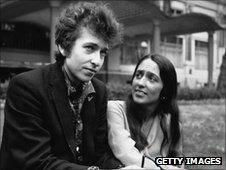
Steve Jobs' music tastes were well known from his product launches.
Singles and albums would regularly flash across the screen of new Macs or iPhones.
The Beatles and Bob Dylan were two of his favourite artists. Getting the rights to sell the fab four's music through iTunes became a long running saga which was eventually resolved in November 2010.
Mr Jobs' top 10 albums, listed on the Apple social music service Ping, also included Kind of Blue by Miles Davis, American Beauty by The Grateful Dead and Who's Next by The Who.
His had a more personal connection to one particular musical icon, having briefly dated Dylan's ex-girlfriend, singer Joan Baez.
One more thing...
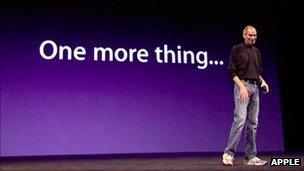
Sometimes you have to save the best for last. Steve Jobs regularly did that when launching products.
Having unveiled a raft of new gadgets, just as guests were getting ready to leave, he would utter the now famous words "One more thing..."
When he did so, there was always a mischievous smile. It was part of his genius as a showman.
One more things have included the Powerbook G4, iPod touch and Facetime video calling.
Steve Jobs' successor, Tim Cook opted not to do a one more thing at the launch of the iPhone 4S in October 2011.
It is unclear if the tradition will continue after Steve Jobs, meaning we may have seen the last ever one more thing.